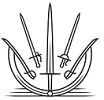Tournament participants must follow the directions of the tournament director and staff at all times. Any participant exhibiting behavior that places themselves or others at risk of harm will result in immediate disqualification and possible intervention by local law enforcement.
- Tournament Goals
- Safety Regulations
- CUTTING QUALIFICATION
- Tier-C Cutting Patterns
- Tier-B Cutting Patterns
- Tier-A Cutting Patterns
- U18 Cutting Patterns
- Quality Standards
- Competitor Conduct
- Equipment
Tournament Goals
The goal of the SoCal Swordfight cutting tournaments is to:
- Showcase/evaluate/reward sword skills that can not be tested in a sparring environment.
- Promote an integrated training regiment, with good cutting mechanics in sparring and good fencing behavior in cutting
- Be creative, educational, and enjoyable for both participants and spectators.
Safety Regulations
All competitors will be required to assume proper safe-handling procedures for sharp swords. This includes, but is not limited to, swinging the sword when there is the possibility of others in the vicinity, losing control of the weapon, or approaching the cutting area before being explicitly instructed to do so by the tournament staff. Should the tournament officials perceive that there is any safety issue, they retain the right to remove individuals from the cutting tournament or cutting qualifiers at their discretion.
Competitors are forbidden to cut toward their lead leg with Descending Cuts.
(Competitors in Tier-A Cutting are free to cut in any direction.)
Cutting Qualification
All participants competing in Open Longsword must complete a cutting qualification.
If you completed the cutting qualification at SoCal 2022, SoCal 2023, or have competed (with some degree of success) in a cutting tournament at any event in 2022 or 2023, you are already qualified. If not, you must attend a cutting qualification on Friday or you will be disqualified from the longsword competition. (There is no limit on the number of re-tries to pass the qualification).
Even if you think you are pre-qualified you are responsible for checking the cutting qualification list to be sure. (when the roster is published)
Cutting qualification shall consists of the following 4 cuts (in any order):
- 1 clean descending cut through the paper from the right.
- 1 clean descending cut through the paper from the left.
- 1 descending cut from the right that is arrested past the half way mark of the paper, but before the end (half-cut).
- 1 descending cut from the left that is arrested past the half way mark of the paper, but before the end (half-cut).
There are 6 total attempts to complete the 4 cuts. (In any order).
The paper is quite wide, approximately 2 feet, so you will need to maintain your sword in the cutting plane for a relatively wide arc. While the paper will not stop your blade like a tatami mat, if you cut poorly it will rip apart rather than cutting.
Tier-C Cutting Patterns
Round 1 - Descending Cuts
Target 1 - Single Tatami Roll
Competitors will perform 3 descending cuts on each side, in any order. (6 total cuts)
Target 2 - Hanging Paper
Competitors must perform 6 descending cuts, 3 on each side.
Top 20 by score will advance to the next round.
Round 2 - More Cuts
Target 1 - Single Tatami Roll
Competitors will perform 3 ascending cuts on each side, in any order. (6 total cuts)
Target 2 - Hanging Paper
Competitors must perform 4 descending cuts, on the same side, in a continuous motion. This will be repeated on both sides.
The recovery between swings need not be fast, but should show no signs of hesitation.
Top 4 by cumulative score advance to the Final Round.
Round 3 - Reactive Cutting
Target 1 & Target 2 - Single Tatami Roll
Competitors will perform cuts as prompted by the tournament staff. (Single tatami mat).
Eligible cuts:
- Descending Right
- Descending Left
- Ascending Right
- Ascending Left
Tier-B Cutting Patterns
Round 1 - Continuous Cuts
Target 1 - Single Tatami Roll
Competitors will perform a total of 6 cuts, alternating between true edge descending and ascending along the same line. Cuts must be performed in a continuous pattern with no delays to recover/re-chamber between.
Target 2 - Single Tatami Roll
Competitors will perform a total of 6 cuts, alternating between true edge descending and ascending along the opposite line as Target 1. Cuts must be performed in a continuous pattern with no delays to recover/re-chamber between.
Top 9 by score will advance to the next round.
Round 2 - Reactive Cutting
Target 1 & Target 2 - Single Tatami Roll
Competitors will perform cuts as prompted by the tournament staff.
Eligible cuts:
- Descending Right
- Descending Left
- Ascending Right
- Ascending Left
Top 4 by cumulative score advance to the Final Round.
Round 3 - Cutting Feats
Feat 1 - Avenger Single Tatami Roll
Target 1 will be a single tatami mat oriented at a 45-degree angle. The competitor must perform as many of the eligible strikes as possible, with each cut only being attempted a single time. These cuts are intended to be performed in a vertical line, and large deviations from vertical will be penalized
.
Example ↓
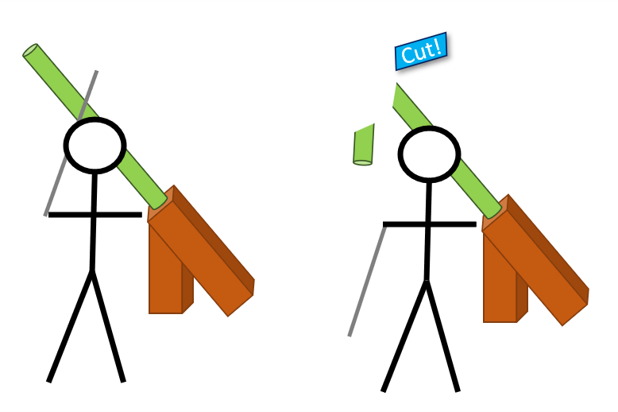
Eligible Cuts:
- Krumphau* (R/L)
- Shielhau (R/L)
- Schietalhau (Single)
Feat 2 - Draw To The Button
Competitors will be presented a sheet of hanging paper with 6 dots marked on it. They will perform each of the 6 basic cuts with the aim of bringing the sword to rest as close to the target dot as possible.
Example ↓

Tier-A Cutting Patterns
Round 1 - Cutting Angles
Target 1 - Avenger Single Tatami Roll
Target 1 will be a single tatami mat oriented at a 45-degree angle. The competitor must perform as many of the eligible strikes as possible, with each cut only being attempted a single time. These cuts are intended to be performed in a vertical line, and large deviations from vertical will be penalized.
Example ↓

Eligible Cuts:
- Krumphau* (R/L)
- Shielhau (R/L)
- Schietalhau (Single)
Target 2 - Close Cuts
Competitors will start with the lead foot touching the cutting stand. They must step backwards and execute a cut towards their lead leg.
Example ↓

Top 8 by score will advance to the next round.
Round 2 - Reactive Cutting
Target 1 & Target 2 - Dowel + Tatami Roll
Competitors will perform cuts as prompted by the tournament staff. (Tatami with dowel).
Eligible cuts:
- Descending Right
- Descending Left
- Ascending Right
- Ascending Left
Top 4 by cumulative score advance to the Final Round.
Round 3 - Cutting Feats
Feats to be announced after the completion of Round 2.
U18 Cutting Patterns
Round 1
Competitors will perform 4 cuts from the same side on a hanging sheet of paper. After this the paper will be reset, and they will perform 4 cuts from the other side.
Finals
Based on the scores from Round 1 the ranking #1 & #2 will be placed in a Gold Medal match, and ranking #3 & #4 will be placed in the Bronze Medal match. For each ‘exchange’ the director will name a cut, and each will complete it. After both have completed the director will declare one of the two competitors the winner of the exchange based on the quality of the cut, and they will receive one point. (A tie, no points, is also possible.)
Once one competitor reaches 3 points they will be the match.
Quality Standards
Base Point Value: A cut with no deductions will be awarded 10 points.
Deductions: Any of the following will deduct from the final score. In the event that multiple infractions are recorded, only the highest value will be applied.
Tatami Deductions
Cut Form
'x' indicates that no points will be awarded.
- [-3]: Stepping ahead of cut Example ↓
If the lead foot is firmly plated while the sword is being chambered/accelerated.
- [-5]: Expose Back Example ↓
The exposes the full side/back while completing the cut.
- [-5]: Entering Waiting Area as Signal Period Ends* Example ↓
Reactive cutting round only.
- [X]: Not In Waiting Area When Signal Period Ends* Example ↓
Reactive cutting round only.
- [X]: Leaving Waiting Area Ahead of Signal* Example ↓
Reactive cutting round only.
Cut Quality
'x' indicates that no points will be awarded.
- [-5]: Small Mountain Example ↓
A mountain is when a cut intersects a previous cut or cut attempt. This is penalized because the competitor no longer needs to cut through the full width of the target, and also because it demonstrates poor targeting and control. Small mountains will be assessed a point deduction of -5 points.

- [-3/-5/-8]: Tatami Landing Distance (yellow) Example ↓
- [X]: Tatami Landing Distance (red) Example ↓
‘Landing Zones’ will be used to assess cutting quality. These zones will be clearly marked on the ground around each cutting stand.
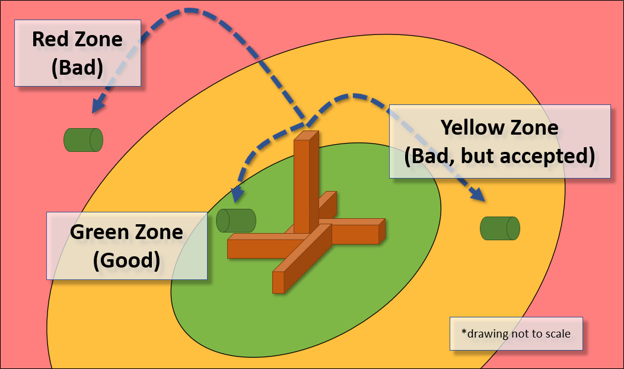
- The zone deduction is assessed based on the position at which the tatami first comes into contact with the ground (i.e. rolling after contact does not impact the score).
- In the event that a clearly defined piece cannot be identified, the cut will be assumed to have landed in the red zone.
- Should a cut spray debris, it will be assumed to have landed in the red zone.
- Should a piece land straddling two zones, it will be assessed as landing in the lower deduction zone.
- [X] Scallop Example ↓
A scallop is defined as a cut which clearly curves its trajectory in the tatami mat. This also applies to any parallel mat cuts which do not have the two cuts in the same line.

- [X] Large Mountain Example ↓
A mountain is when a cut intersects a previous cut or cut attempt. This is penalized because the competitor no longer needs to cut through the full width of the target, and also because it demonstrates poor targeting and control. Cuts with mountains of greater than 1” (25.4 mm) will be awarded no points.

- [X] Tatami Surface Not In Line With Cutting Plane Example ↓
This is a phenomenon that can occur with extremely sharp swords which are highly optimized for cutting. If the tatami ends up cut on a different plane than the one on which the sword was swung, it indicates that the competitor performed a ‘failed’ cut, but that their sword was able to overcome this and still pass through the thin tatami targets.
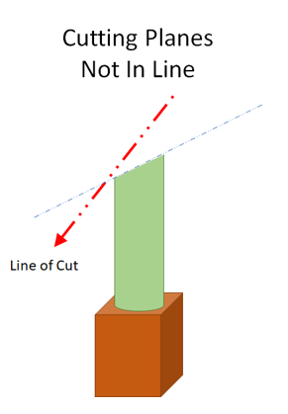
- [X] Cut Below Limit Example ↓
The lowest rubber band on the tatami mat will indicate the lowest height a competitor may cut at. Any cuts that pass below this line will receive no points. Should the competitor hit the stand or floor, they will receive no points for the cut and instead have a value of -10 applied to their overall score.
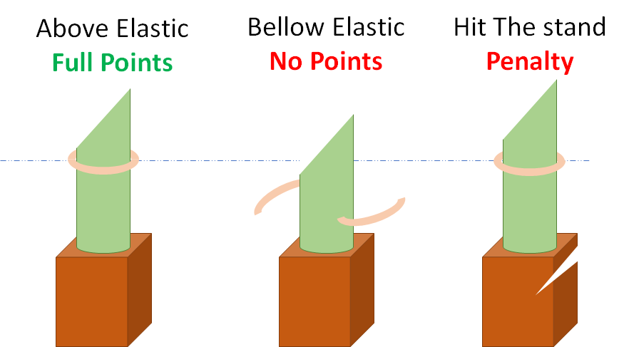
- [X] Failed Cut
- [X] Wrong Cut
Paper Deductions
Paper cutting will be performed on a vertical hanging paper. The paper offers lower resistance than tatami, but can rip more easily and tests for a much larger cutting line.
Each paper cut, without deductions, is worth a base of 4 points. 'x' indicates that no points will be awarded. These are also not passing cuts for the purpose of cutting qualification.
- [-1]: Roughness Example ↓
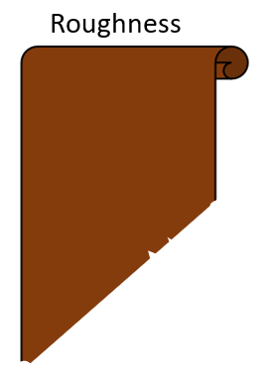
- [-1]: Paper Flutter
- [-2]: Small Rip Example ↓

- [-2]: Small Scallop Example ↓

- [-2]: Sound of impact or strong paper flutter
- [X]: Extremely loud impact sound and violent paper movement.
- [X]: Ripped Paper Example ↓
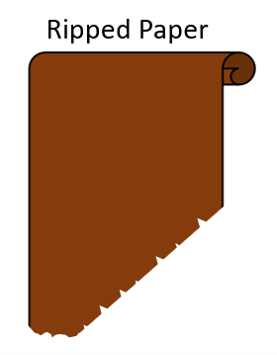
- [X]: Large Scallop Example ↓

Competitor Conduct
Competitors shall not begin cutting until instructed to do so by the tournament staff. Following the completion of each cut, the competitor must wait for confirmation from the cutting judges before beginning their next cut. After assessing the quality of a cut, the cutting judges will hold up a color-coded card to provide feedback to the cutter and the audience and to indicate that the competitor may make their next cut. A competitor may not address the table to inquire about a score which has been awarded. These cards will be:
- Green - No point deduction on cut
- Yellow - Point deduction on cut
- Red - No points awarded on cut
- Verbal Warning - Penalty assessed
Should a competitor request a mat straightening (provided the round allows for it), they must first step out of the cutting area with the tip of their sword pointed toward the ground. The competitor must not move until instructed to do so by the tournament staff.
Competitors that take excessive time to begin after they have been signaled to cut will be warned by the tournament staff, and may be subject to penalties if there are repeated infractions. While it is not necessary for a competitor to rush after they are prompted, it is intended that they perform the cut in a short period of time without spending considerable time ‘fidgeting’ or ‘psyching themselves up.’
During reactive cutting rounds, the competitor must wait in an area designated by the tournament staff. Only once the cut has been signaled may they move forward and execute their cut. The competitor must then return to the waiting area before the signaling period has concluded or be assessed a point deduction on the cut.
Equipment
There will be a loaner longsword available.
European longswords only. No zweihanders, no messers. If you are using something that isn't sold as a longsword by a reputable European sword manufacturer you must get approval for the sword.
The tournament is under no obligation to let you use a sword that you've brought.



























